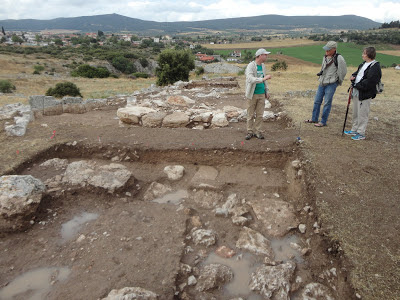 |
| View of the excavation on June 17th, 2013 |
I am in charge of excavating a room in one of the house tombs. This ca. 2 x 3 m space was used for the secondary burial of disarticulated skeletons. The complete vessels we’ve taken out so far indicate a date in MM I for the deposition. We carefully uncover the clusters of bones and crania then draw and photograph them before removing them. Below this is another layer and so it goes until we reach bedrock.
 |
| View of the excavation on June 27th, 2013 |
Institute members in eastern Crete this summer
Last Saturday evening the INSTAP Study Center for East Crete in Pacchia Ammos held its first lecture of the summer. Prof. Pietro Militello (University of Catania) gave a well-researched and well-illustrated lecture on craft production in the palatial period in and around the palace at Phaistos and the structures at Ayia Triada based on the material culture records and the Linear A texts recovered at both sites.
CIG was well represented among the numerous people in attendance. These included Rod Fitzsimons (Trent University) who is drawing the architecture at the nearby excavation at Azoria (ASCSA); Tristan (Stringy) Carter (McMaster University) who is studying the chipped stone material from the excavations at Mochlos (ASCSA); Angus Smith (Brock University) who is studying the pottery from the excavations at Gournia (ASCSA); Maria Liston (University of Waterloo) who was there to attend the meeting of the Managing Committee of the Center; and Scott Gallimore (Wilfrid Laurier University) who is leading a field school at Gournia again this summer. There are some Brock students as well at Gournia with Angus Smith. Rachel Dewan who was the Wilfrid Laurier University undergraduate intern at CIG this past fall is back at Gournia too. As there were so many people I may have missed someone, alas.
Now I must write up my trench notebook for today. More soon!
Cordially,
David Rupp
Directoρ










